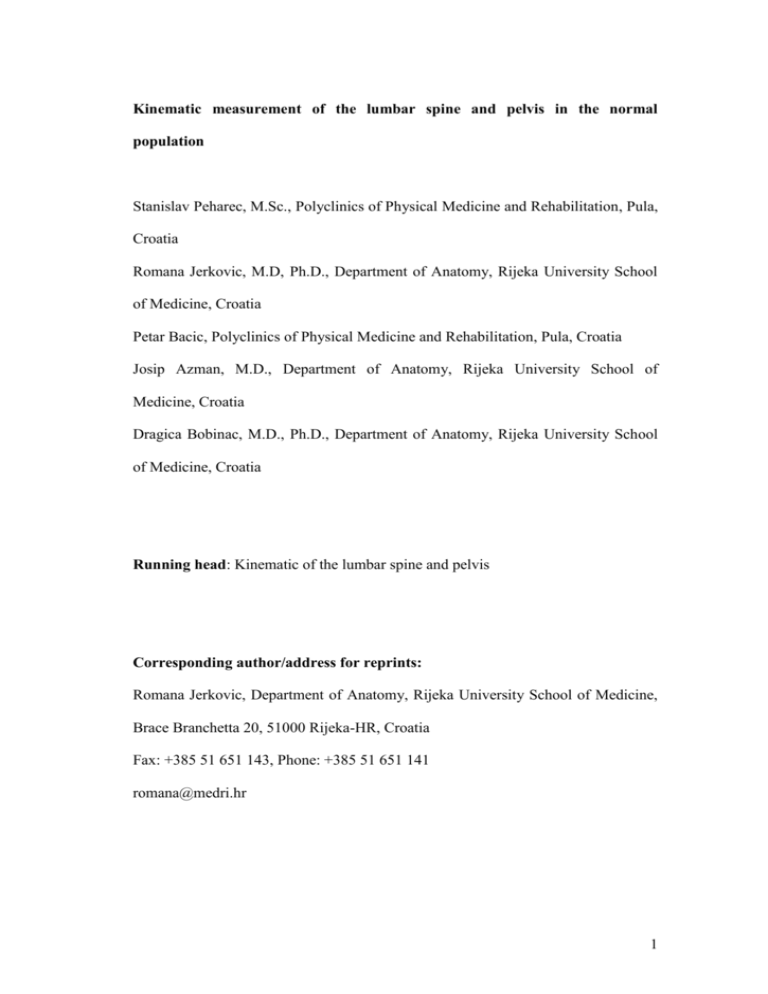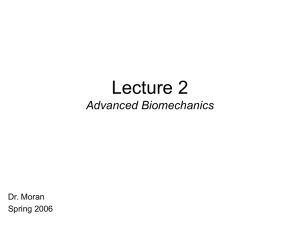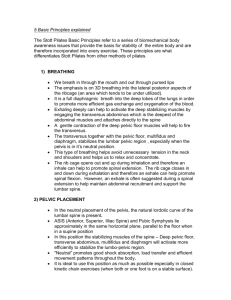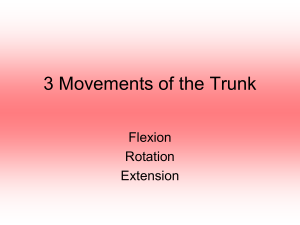INTRODUCTION
advertisement

Kinematic measurement of the lumbar spine and pelvis in the normal population Stanislav Peharec, M.Sc., Polyclinics of Physical Medicine and Rehabilitation, Pula, Croatia Romana Jerkovic, M.D, Ph.D., Department of Anatomy, Rijeka University School of Medicine, Croatia Petar Bacic, Polyclinics of Physical Medicine and Rehabilitation, Pula, Croatia Josip Azman, M.D., Department of Anatomy, Rijeka University School of Medicine, Croatia Dragica Bobinac, M.D., Ph.D., Department of Anatomy, Rijeka University School of Medicine, Croatia Running head: Kinematic of the lumbar spine and pelvis Corresponding author/address for reprints: Romana Jerkovic, Department of Anatomy, Rijeka University School of Medicine, Brace Branchetta 20, 51000 Rijeka-HR, Croatia Fax: +385 51 651 143, Phone: +385 51 651 141 romana@medri.hr 1 ABSTRACT: Spinal and pelvis motion has been studied by a variety of different methods, the majority of which have a number of limitations. The present study investigated dynamic motion characteristics of the lumbar spine and pelvis using a threedimensional optoelectronic device. The aim of our study was to determine kinematic parameters of spine and pelvis in trunk flexion, extension and lateral bending in normal, healthy subjects. Kinematic motion analysis was performed in 63 asymptomatic volunteers for four different trunk motions. The results have shown the gender differences in pelvic motion. Contribution of pelvic movement to trunk flexion was 50%, while pelvic angle was significantly higher in women. During lateral bending female subjects had statistically significant higher values of vertebral angle. During extension the contribution of pelvic movement was 45%. There was no significant difference found in total angle, pelvic angle and vertebral angle. This study have shown that the pelvis range of motion is affected by the gander. 2 INTRODUCTION Mobility of the spine and pelvis depend on physical and anatomical characteristics of lumbar and pelvic regions and leg. For measuring trunk’s mobility in sagittal plane several non-invasive methods have been described which, however, display certain limitations. Kinematic measurements enable us to measure mobility during the whole motion of all body parts we wish to examine. During the last few years, three-dimensional motion-measuring techniques have been developed (1,2,3,4) with skin markers which enable precise and quick measurement of the whole motion range and its dynamics. Considering that kinematic assessment of motions and spine and pelvis coordination is used for the assessment and follow-up during the course of rehabilitation for patients with low back pain, it is important to identify the range of motion (ROM) in asymptomatic, healthy subjects. Loebel and al. used goniometer to measure spine flexion and extension analyzing mobility according to gender and age. Results of the study showed that total mobility of the spine decreased with age on average 8 degrees per decade. He found no significant differences between men and women. (5). Measuring trunk’s mobility in healthy subjects using the kinematic system, McGill and al. concluded that flexion and lateral flexion mobility decreased with age. (6). Einkauf and al. measured flexion, extension and lateral flexion trunk motions in healthy women of 20 to 84 years of age using Schober method and goniometer. Results indicated the decrease in mobility with age for all motions examined. (7). Macrae et al., by using modified Schober method, conducted measurements and compared lumbar spine flexion and extension values in healthy subjects according to gender and age. Results of this study showed higher flexion mobility in men and significant decrease of lumbar flexion with age. 3 Measurements of healthy subjects showed that mobility decreased with age. There were no differences found in mobility according to gender except in the study by Macrae and al. who showed greater flexion in men (8). Lateral flexion in relation to the dominant side of the body showed no statistically significant difference. The aim of the present study is to determine relationship between the movements of the lumbar spine and hips during trunk motion. The range of trunk extension and flexion and lateral bending (both right and left) was exemined in normal, healthy population. Moreover, differences in motion range in regard to gender were investgated. MATERIALS AND METHODS This study included 63 examinees of good health with no history of back pain in the lumbar spine within the last three years. Subjects sample included 40 male (63%) and 23 women (37%) with the mean age of 35 years. All subjects were informed about the details of the procedure and that the measurement is performed for scientific research purposes. Subjects willfully participated in the research study and signed their written consent. Subjects could have refused further participation at any stage of the research. Kinematic measurements were performed with 3D optoelectronic device (Smart, BTS, Padua, Italy) with 9 CCD cameras of 50Hz (version 1.10, Build 2.39). Infrared sensitive markers were adjusted to 15 anatomical spots: left and right lateral part of the ankle, left and right lateral part of the knee in the middle part height relating to the joint fissure, left and right trochanter, left and right of the iliac crest, spinal endings S1, L3, Th12, Th6, C7 and left and right acromion. 4 Measurements were performed during the period from 9.00-13.00 hours in order to lessen the influence of daily activities on measuring results. Measurements were performed in a biomechanical laboratory at room temperature. Movement measuring protocol required from the subjects to perform trunk flexion/extension in a standing position and a lateral trunk flexion in a standing position. Each measurement was repeated five times. Measurement began from vertical neutral position and followed with continuous movements. Figure 1. Markerization with 15 spherical markers of 10 mm in diameter. Using calculation protocol called Vertebral Kinematic Analysis (VKA) developed for functional spine examination , kinematic values were singled out for further statistical analysis. VKA calculations enabled us statistical analysis of following kinematic variables: pelvic angle (PA), total angle (TA), vertebral arc angle (VA), lower lumbar segment angle (Ls2), upper lumbar segment angle (Ls1), lower thoracic segment angle (Ts2), upper thoracic segment angle (Ts1). VA angle actually consists of four 5 spinal segment angles sum: Ts1+Ts2+Ls1+Ls2. Angle movement velocity was also calculated. For each subject, mean of measured values and variation coefficient (CV) were recorded (CV=standard deviation/mean x 100%; mean=arithmetic mean of 5 consequent measurements of the subject, and SD is its standard deviation). Measuring results were entered into the relational table formed in MS Excel. Statistical analysis was done by computer program STATISTICA version 6. (StatSoft Inc., Tulsa, OK, USA). RESULTS The values of total angle, pelvic angle and vertebral in trunk flexion, extension and lateral flexion are presented in Figure 2. Flexion Contribution of pelvic movement to trunk flexion was 50%. Total angle, pelvic angle and vertebral angle were compared according to gender. Pelvic angle was significantly higher with women (ANOVA, F=4.88, p=0.029). Total angle and vertebral angle were higher with women but not statistically significant. Extension Contribution of pelvic movement during trunk extension was 45%. Total angle, pelvic angle and vertebral angle were also compared according to gender and there was no significant difference found. Women had similar values of total angle, almost identical values of pelvic angle and lower vertebral angle values compared to men. 6 Lateral flexion Gender comparison regarding vertebral angle discovered that female subjects had statistically significant higher values (right: p=0.012, left: p=0.002) in contrast to comparison of total angle and pelvic angle values where no statistically significant differences were found. DISCUSION Kinematic spine measurement aims to determine biomechanical characteristics of the spine and pelvis during different trunk movements. The purpose of kinematic spine measurement in healthy subjects is determining levels of mobility according to age, gender, dominant side of the body and daily changes in mobility (1, 5-13). There were no differences in mobility found according to gender except in the study by Macre who determined a greater range of trunk flexion motion in men (8). For the success in rehabilitation and treatment of patients with low back pain (LBP), remission of neurological symptoms are equally important as the recovery of functional features such as mobility, flexibility, strength and endurance of the musculature as well as the recovery of neuromotor control (14-19). Practical significance of kinematic measurement lies in planning and programming a process of rehabilitation. Namely, the results obtained represent a starting point for programming and conducting the rehabilitation procedure adjusted to individual functional features of the patient with LBP. In case of persistant functional deficit there is a higher probability of recurrence of LBP episodes. Wong and al. points out the importance of mobility measurements in clinical practice with the purpose of functional assessment of patients with back pain and rehabilitation efficiency evaluation (20). In comparation between 7 groups of subjects according to gender, angle values during flexion indicated statistically significant higher pelvic angle value in women. Although with no statistical significance, higher value of the total angle was also determined in women of all ages. Results obtained are in accordance with already published studies in which there were no statistically significant differences found in trunk flexion and extension according to gender. (1,5,13). Trunk flexion in average healthy subjects was 114,4012,50 which is close to values from the study by Esola et al. where flexion value was 1110 (2). Mobility of the pelvis compared to the total angle was around 50% movements for both groups of subjects compared to 37% (21), 61,1% (3,22) and 62,5% (2). We can assume that significant differences in pelvic mobility probably arise from different measuring methods. Lateral flexion angle value in Lariviere study resulted to be 380 for both sides and in our study around 350 (3,22). According to gender, there were no significant differences found which is in accordance with the results by McGregor and al. (13,23). Lateral flexion according to the side of bending showed no significant difference which is in concord with the results of previous research studies (1,12). Kinematic analysis conducted in this study contributes to the functional assessment of lumbopelvic region. 8 REFERENCES 1. GRACOVETSKY, S., N. NEWMAN, M. PAWLOWSKY, V. LANZO, Spine, 20 (1995) 1036. 2. ESOLA, M.A, P.W. MCCLURE, G.K. FITZGERALD, S. SIEGLER, Spine, 21 (1996) 71. 3. LARIVIERE, C., D. GAGNON, P. LOISEL. Clin Biomech, 15 (2000) 407. 4. FITZGERALD, G.K., K.J. WYNVEEN, W. RHEAULT, B. ROTHSCHILD, Phys Ther, 63 (1983) 1776. 5. LOEBL, W.Y., Ann Phys Med 9 (1967) 103. 6. MCGILL, S.M., V.R. YINGLING, J.P. PEACH, Clin Biomech, 14 (1999) 389. 7. EINKAUF, D.K., M.L. GOHDES, G.M. JENSEN, M.J. JEWELL, Phys Ther, 67 (1987) 370. 8. MACRAE, I.F., V. WRIGHT, Diseases, 28 (1969) 584. 9. ENSINK, F.B., P.M. SAUR, K. FRESE, D. SEEGER, J. HILDEBRANDT, Spine 21 (1996) 1339. 10. MELLIN, G., Spine, 13 (1988) 668. 11. MELLIN, G., R. KIISKI, A. WECKSTROM, Spine, 16 (1991) 1108. 12. NG, J.K.F., V, KIPPERS, C.A. RICHARDSON, M. PARNIANPOUR, Spine, 26 (2001) 53. 13. MCGREGOR, A.H., I.D. MCCARTHY, S.P. HUGHES, Spine, 20 (1995) 2421. 14. SNOOK, S.H., B.S. WEBSTER, R.W. MCGORRY, M.T. FOGLEMAN, K.B. MCCANN, Spine, 23 (1998) 2601. 9 15. MAGNUSSON, M.L., J.B. BISHOP, L. HASSELQUIST, K. SPRATT, M. SZPALSKI, M.H. POPE, Spine, 23 (1998) 2631. 16. SHIRADO. O., T. ITO, T. KIKUMOTO, N. TAKEDA, A. MINAMI, T.E. STRAX, Spine, 30 (2005) 1219. 17. JUKER, D., S. MCGILL, P. KROPF, T. STEFFEN. Med Sci Sports Exerc, 30 (1998) 301. 18. NELSON, B.W., D.M. CARPENTER, T.E. DREISINGER, M. MITCHELL, C.E. KELLY, J.A. WEGNER, Arch Phys Med Rehabil, 80 (1999) 20. 19. HIROMICHI, K., S. KENICHI, N. OSAMU, Y. ISAKICHI, T. SYUICHI, F. KOHTARO, Spine, 21 (1996) 225. 20. WONG, T.K.T., R.Y.W. LEE, Hum Mov Sci, 23 (2004) 21. 21. MAYER, T.G., A.F. TENCER, S. KRISTOFERSON, Spine, 9 (1984) 588. 22. LARIVIERE, C., D. GAGNON, P. LOISEL, J Electromyogr Kinesiol, 10 (2000) 79. 23. MCGREGOR, A.H., H.R. CATTERMOLE, S.P.F. HUGHES, J Bone Joint Surg, 80 (1998) 1009. 10 Figure 2. Total, pelvic and vertebral angle during flexion, extension and lateral bending in healthy persons. Data are expressed as mean standard deviation. 11 AUTHORS Stanislav Peharec, M.Sc., Polyclinics of Physical Medicine and Rehabilitation, Rizzijeva 101, 52001 Pula, Croatia Romana Jerkovic, M.D, Ph.D., Department of Anatomy, Rijeka University School of Medicine, Brace Branchetta 20, 51000 Rijeka, Croatia Petar Bacic, Polyclinics of Physical Medicine and Rehabilitation, Rizzijeva 101, 52001 Pula, Croatia Josip Azman, M.D., Department of Anatomy, Rijeka University School of Medicine, Brace Branchetta 20, 51000 Rijeka, Croatia Dragica Bobinac, M.D., Ph.D., Department of Anatomy, Rijeka University School of Medicine, Brace Branchetta 20, 51000 Rijeka, Croatia 12 13








